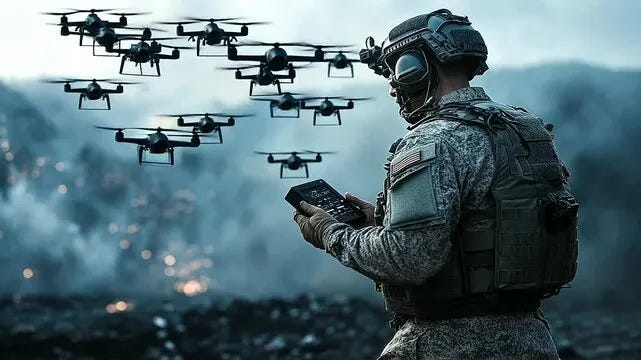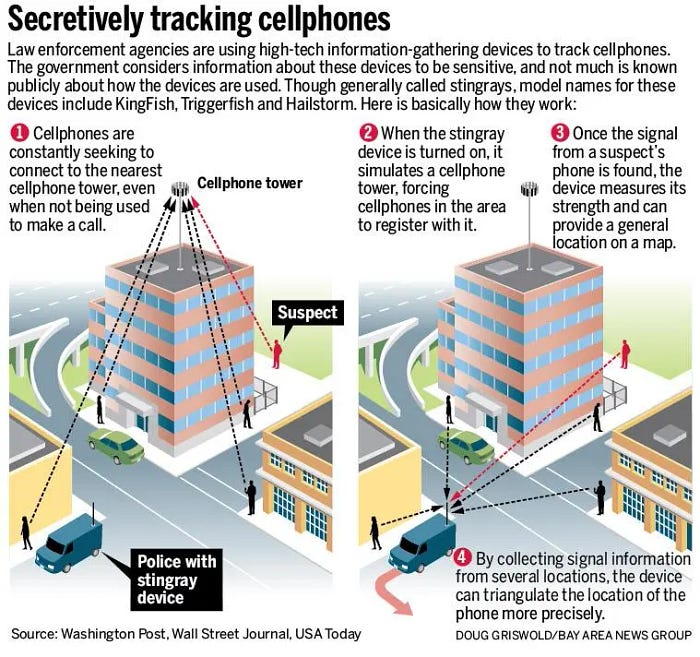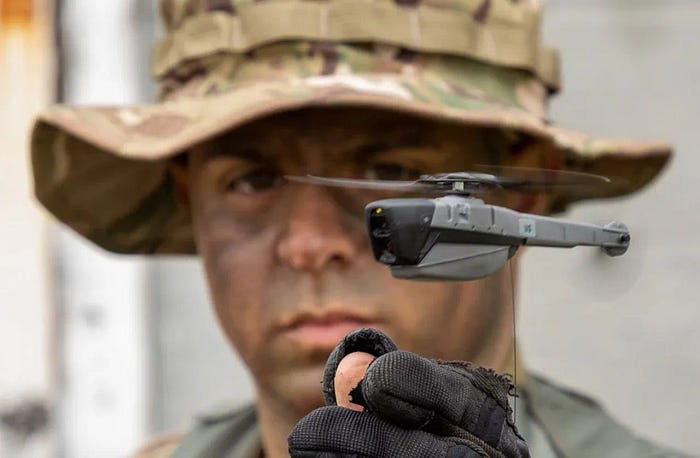Non-members can free for free here.
"Spying among friends is never acceptable." — Angela Merkel
As a hobbyist drone operator myself, I can appreciate the challenges of operating drones, the legal do's and don'ts and grey areas, as well as the allure of all the cool things you can do with them. After all, a "bird's eye" view of the world is so much more intriguing and different from the ground level view of the world that we are accustomed to seeing in our everyday lives. Drones offer the advantage of being able to see what's over the ridge, across the street or field without leaving your position.
However, it appears the commercial industry backed by government taxpayer dollars are designing microscopic-sized drones that are capable of infiltrating nearly any building. Tiny drones are on a whole different technology level, one that simply isn't available or affordable to every day people unless your last name happens to be Bezos, Musk, or Zuckerberg. It's true that some technology is out of reach for all but the ultra-wealthy and powerful. Journey with me on a brief foray into the modern marvels of aerial drones.
Attack of the Drone Wars

Drones, or Unmanned Aerial Vehicles (UAV), also sometimes called First-Person View (FPV) drones, are a new(er) technology but they're certainly not "new" in the sense that we've never seen them before or don't understand what they are and how they can be used. On the contrary, drones have been used extensively by the military for intelligence spy collection and now even in modern warfare. Of course nowadays, whatever the military has, our paramilitary law enforcement agencies will try to purchase in the current trend of the militarization of U.S. law enforcement.
In fact, in the U.S. we even have drones flying over American cities operated by both Federal and local Law Enforcement Agencies (LEA) collecting video intelligence for various purposes. Additionally, commercial companies like Amazon experimenting with drone deliveries of items in cities, and hobbyist drone operators like myself who enjoy flying them. Other companies such as Wing, Flytrex, Matternet, Zipline, Elroy Air, Manna, UPS Freight Froward, DroneUp, Joby Aviation, Wisk Aero, Wingcopter, and Zing also use drones to deliver goods (Kawamoto, 2024). Indeed, the skies 400 feet (122 meters) above ground level are starting to get a little congested at times depending on where you're located.

Some of the medium-to-larger drone models can also be equipped with Stingrays, otherwise known as International Mobile Subscriber Identifiers (IMSI) catchers or cell-site simulators. These devices are sometimes used by law enforcement agencies during criminal investigations where the stingray serves as a fake cell phone tower.
In the background process of your cell phone, it constantly tries to connect to and establish connections with the nearest cell phone tower and will unknowingly connect to the police stingray thereby enabling the illegal harvesting of thousands of private citizens' cell phone data. That is partly how the cell phone triangulation can be used to pinpoint where someone is located. Unfortunately, there are no safeguards with the cellular protocols currently in use to prevent your cellular device from inadvertently connecting to a fake cell phone tower. You could place the phone in "Airplane" mode or remove the battery, but that's not very practical for most people.
Now, I say "illegal" because this police tactic falls into a legal grey area and is a clear violation of the Fourth Amendment rights of the U.S. Constitution against unlawful search and seizure. The courts have not put an end to this practice as of yet, just as they've not put an end to the National Security Agency (NSA) and other Intelligence agencies spying on American citizens under the The PATRIOT Act which keeps getting renewed despite being another clear example of Fourth Amendment rights violations. As is often the case, however, U.S. and even international law lags behind technological development and application.
It's been well over 24 years since the 9/11 terrorist attack occurred and The PATRIOT Act is still on the books for "National Security" purposes. You give the government an inch and they take three miles with no intentions of ever stopping. Every time The PATRIOT Act comes up for renewal, the same 3-letter government agencies whine on and on about how decimating it will be to their intelligence collection efforts if lawmakers don't renew it. It makes one wonder how these clowns ever performed their jobs before 9/11?
Even if police had warrants signed by a judge to conduct stingray cell phone interceptions, something we as everyday citizens can never be assured of, these Geofence warrants are illegal and should never be granted in such a broad manner where innocent private citizens have their phone data scooped up with targeted criminals. Law enforcement use the Stingrays to precisely pinpoint phone locations without assistance from telecom providers (e.g., AT&T, T-Mobile, Verizon) and they log IMSIs which are unique to your cell phone's Subscriber Identity Module (SIM) card. With that information, a simple subpoena to the phone carrier will determine the owner of the phone.
So, what exactly do stingrays have to do with drones, though? Well, not that much right now, but as technology and specifically miniaturization of technology have advanced and continue to advance over time, there concern among privacy advocates and Fourth Amendment protection groups that police are using advanced stingray devices marketed under the name "Hailstorm" that are affixed to low-flying aircraft, or even drones (Restore the Fourth, 2025).
The implications of this are not good, of course, as history has shown that all levels of government abuse their authority from time-to-time unless held accountable by citizens and it only further enforces the stereotype that we're living in the highest state of surveillance in history. The mechanisms for holding government accountable are eroding or disappearing outright and technology is only getting better with time.
For example, in May 2020, the Baltimore Police Department launched its Aerial Investigation Research (AIR) Pilot Program in which surveillance drones flew over 90% of the city for 12-hours a day for 3 months straight (Sobel, 2020). This drone coverage allowed police to track individual citizens' movements over multi-day periods and complemented the already vast network of over 800 CCTV surveillance cameras and Automated License Plate Readers (ALPR) it has operating in the city (Sobel, 2020). Is this bad on the face of it? Not necessarily, it's only when you consider how it can be misused that it becomes an issue. Enough speculating though, let's get back to micro-drone capabilities…
Like something straight out of a James Bond movie, the CIA apparently invested Research and Development (R&D) money into the development of insect-sized spy drones as early as the 1970s according to the Business Insider video linked (above). Back then though, even the faintest crosswind would derail the drone and render it pretty much useless. I think we can confidently conclude that technology has evolved greatly since the 70s, micro drones today would be capable of so much more. However, there's no getting physics and windy weather would be challenging.
It was reported that the United States Air Force (USAF) was in development of insect-like drones designed to mimic insect flight patterns for covert and targeted operations over thirteen years ago that they termed "micro air vehicles", or MAVs (Kent, 2012). The idea is that these MAVs could be dropped from an aircraft from thousands of feet above the battlefield in swarms and provide valuable intelligence to commanders of where enemy units and positions are located, helping in the decision making process.
In a time when we've already seen how drones have been used by both Ukraine and Russian forces, with some larger drones even equipped with bombs used to take out single enemy soldiers. Russia has used drones in Estonia and Sweden (Lewinski, 2025) which have been shot down by NATO aircraft with Russia claiming they didn't violate the other country's sovereign air space. These remote controlled tiny drones would be very difficult to detect or see with the naked eye, making them advantageous for deployment behind enemy lines.
*Warning: The video linked below contains graphic images of actual combat.
The MAVs transmit their precise GPS coordinates to pilots via communication signals that can be controlled via satellite or aircraft flying overhead, and that geolocational data can be used place precision guided munitions accurately on target in real time (Kent, 2012). Think about that for a minute, how advantageous it would be to have live video of enemy combatants without them knowing your seeing them through a camera on a nano drone. If this technology were available in previous world wars, the outcome may have been different.
"The problem with micro drones is that their small size also means small batteries. That limits the range of operations, requiring the attacker to be in close proximity to the target," says Kallenborn, an advisor on strategic technologies with the Center for Strategic and International Studies (CSIS), a bipartisan, nonprofit policy research organization in Washington, D.C.
Micro-drones could be used to deploy chemical and biological warfare weapons, however, there are remote control range limitations on tiny drones associated with their small battery and antenna sizes (Lewinski, 2025). The drones could be used either offensively for spy or lethal attack purposes, or defensively to protect personnel and installations from other drones. Of course, artificial intelligence (AI) will eventually be incorporated to control the drones.
In closing, it's clear that we've only just begun to scratch the surface of what drones can be used for or how they'll be used in modern warfare. As a technologist and hacker, tech such as drones is fascinating to me because I'm always thinking of ways in which tech can be used differently. Using tiny drones to spy on people is a prime example of that. It's only a matter of time before these tiny drones are being sold in the spy gadget novelty stores and we have peeping toms stepping their game up to a whole new level.
From a national security perspective, these things are a nightmare. It's good thing that radio signals don't work inside SCIFs due to the construction specifications or we might soon see a FB live video broadcast of classified conversations and briefings from a remotely controlled mosquito drone. Don't think the application of tiny drones is lost on our adversaries either, who are no doubt investing millions into R&D to manufacture tiny drones for spy purposes. Every nation spies, but the degree to which innovative technologies like micro-drones are employed is a telling factor into how well-resourced and advanced another nation is.
As a cybersecurity engineer, naturally my thoughts drift to what classes of vulnerabilities are associated with RF signal jamming —signals being more of the Electronic Warfare (EW) side of asymmetric warfare, not hacking per se, and also what types of software flaws different drones have that can be exploited to disrupt or brick enemy drones. Being a hacker, you've got to think creatively, outside the box. That's the challenge, think about finding ways of manipulating or disrupting electronic devices that manufacturers and the operators of such devices didn't think of. But that's a story for another time…
Hey, you! Thanks for reading my content. If you enjoyed the read, don't be shy and feel free to give it up to 50 claps. Believe it or not, your continued support makes future writing possible. If you liked this piece, there are hundreds more articles you can access at my profile on different topics and genres. You can also sign up for emails when I publish on Medium, or join Medium to directly support me and other writers to gain full access to all Medium member-only stories.
*If you feel so inclined, all of my published work can be found here.
References
Kawamoto, D. (2024, April 24). 13 Drone Delivery Companies to Know. Retrieved from https://builtin.com/articles/drone-delivery-companies
Kent, R. (2012). US Air Force Develop Insect-Like Drones For Covert &Targeted Operations. Retrieved from https://www.occupycorporatism.com/2013/02/20/us-air-force-develop-insect-like-drones-for-covert-targeted-operations/
Lewinski, J.S. (2025, October 15). America Is Creating Stealth Micro-Weapons — And They Could Be the Secret to Winning Wars. Retrieved from https://www.popularmechanics.com/military/weapons/a69021176/micro-drones-stealth-warfare/
Restore the Fourth. (2025). Stingrays. Retrieved from https://restorethe4th.com/issues/stingrays/
Sobel, N. (2020, November 30). EFF Urges Federal Appeals Court to Rehear Case Involving Unconstitutional Baltimore Aerial Surveillance Program. Retrieved from https://www.eff.org/deeplinks/2020/11/eff-urges-federal-appeals-court-rehear-case-involving-unconstitutional-baltimore

